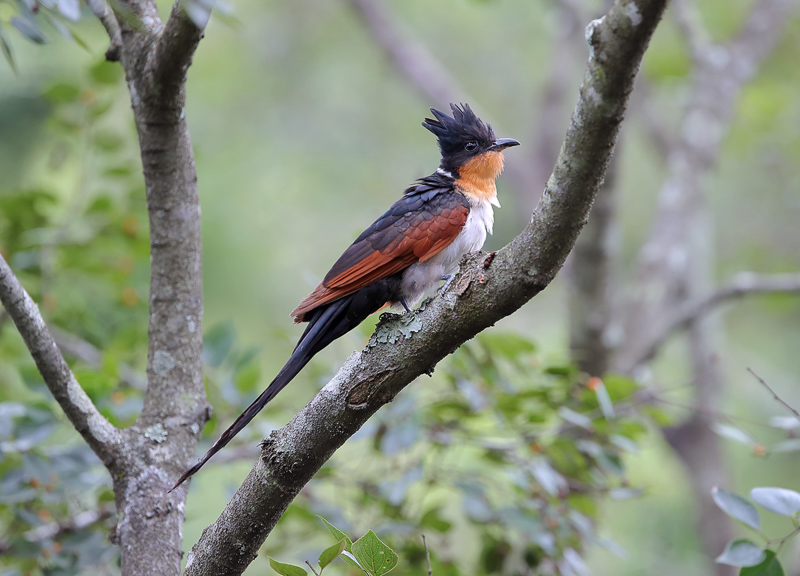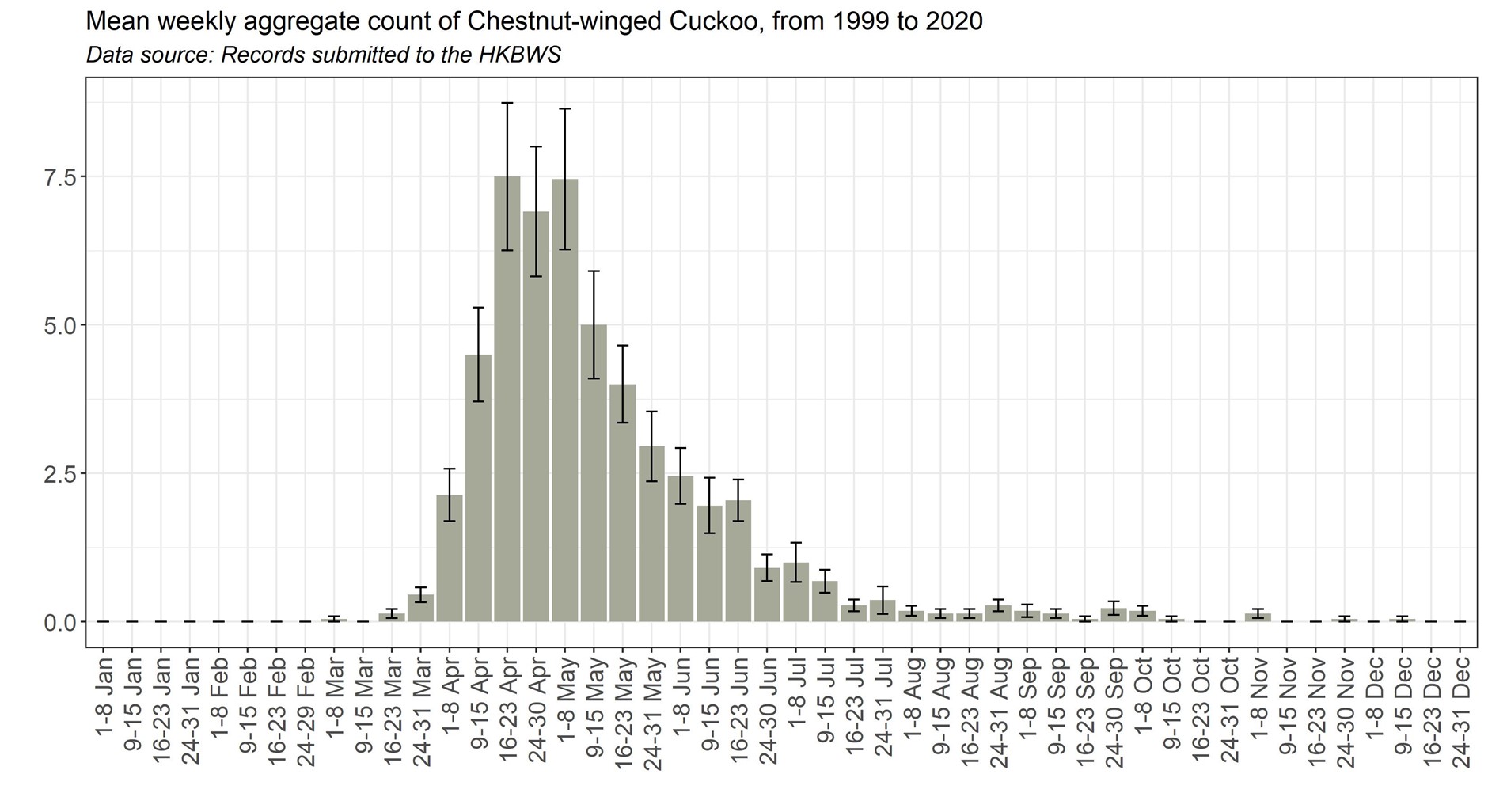Chestnut-winged Cuckoo Clamator coromandus 紅翅鳳頭鵑
Category I. Uncommon summer visitor and scarce passage migrant.
IDENTIFICATION

Jun. 2020, Michelle and Peter Wong.
45-47 cm. A long-tailed cuckoo of striking appearance. Adults have a black head and prominent black crest, white hind collar, black mantle and tail and chestnut-red wings; the underbody is mostly whitish except for an orange-buff throat patch and blackish vent. Juveniles have a shorter, paler crest and pale buffy tips to the upperpart feathers. Iris reddish-brown, bill black, legs and feet black.
VOCALISATIONS
The song, heard during the day and also at night, is a two-note metallic whistle ‘pee pee’ frequently repeated. Birds are often heard giving rather degraded versions of this.
The song may be accompanied by a series of harsh rattling ‘chu-hu-hu-hu-hu-hu’ notes, or these may occur in isolation when excited. Another call, described as a throaty ‘cheegh ha-ha-ha’, is occasionally heard, as well as other poorly-developed sounds.
DISTRIBUTION & HABITAT PREFERENCE
Chestnut-winged Cuckoo occurs in the breeding season in widespread parts of the New Territories, though not usually above 600m asl, as well as locally on HK Island and Lantau and occasionally on Lamma and Po Toi. It also occurs during passage periods at migration hotspots such as Mount Davis and Ho Man Tin and on offshore islands such as Cheung Chau, Tung Ping Chau and Tung Lung Chau. Birds on territory in the breeding season utilise a variety of wooded habitats, especially closed-canopy shrubland, forest, fung shui woods near villages, open stands of trees on the edge of farmland or marshes and occasionally mangroves. Passage migrants are sometimes found in more open habitats or at the urban edge, including urban parks.
OCCURRENCE
Chestnut-winged Cuckoo has been recorded between 5 March and 9 December, with over 95% of the total in the months April to July (Figure 1). Vocalising birds have been noted from 5 March to 18 July and account for almost all records in this period. From a low in March, numbers rise rapidly to peak from the third week of April to the first week of May, then fall steadily to the end of June and into the first half of July. Records are less than annual in March, August and September, and sporadic in October and November, with one further record in December.
All records from August onwards are presumed to involve passage migrants. A small number of records from migration hotspots in the period 9 April-12 May are also thought to involve passage migrants, but records from March to July otherwise refer to local breeders, with main departure probably occurring in July.
Most records are of one or two birds. Highest counts are in areas of mature shrubland - ten between Yung Shue O and Cheung Sheung on 26 April 1997 and seven at Robin’s Nest on 22 April 2019. Larger numbers recorded in other habitats include four at Mai Po NR on 18 April 2013 and five in forest in Tai Po Kau on 29 April 2015. The earliest and latest records involve single birds in the Lam Tsuen Valley on 5 March 2009 and on Po Toi on 9 December 2018.
Single birds in the Lam Tsuen Valley on 13 April 1957 and at Tai Po Kau on 14 October 1957 (Walker 1958) were the first records for HK, but it remained rare with only four further records in the years 1971-1977, three in autumn and one in spring. Since 1978 it has been recorded annually and predominantly in spring, with numbers increasing in the 1990s when it was regarded as uncommon (Carey et al. 2001), as it is now.
Results of the two breeding season surveys, if taken at face value, point to a distributional decline, with the percentage of occupied 1 km grid squares falling from 9.6% in the Breeding Survey of 1993-1996 to 7.5% in that of 2016-2019. A distributional decline, though to a lesser degree, is also suggested by results of the two Nightbird Surveys, with the species detected in 14.9% of shrubland or forest squares in 2000-2001 (Lewthwaite & Yu 2007) and in 13.9% of such squares in 2020-2021 (Lewthwaite & Fong in prep.).
BEHAVIOUR, FORAGING & DIET
Birds call from a perch in a tree or in flight and are vocal by day and to a lesser extent by night. Site fidelity was shown by one that, after being captured at Kadoorie Agricultural Research Centre (ARC) on 27 April 1996, was retrapped there on 23 May 1996, then at KFBG (less than 1 km away) on 8 April 1997, and at Kadoorie ARC again on 9 June 1997 (Melville & Leven 1999).
BREEDING
There are no observations of chicks in a nest in HK, but since 1994 single fledged juveniles, either accompanied by a possible foster-parent or alone, have been noted from 21 May to 24 August, mainly at forest or shrubland sites such as Hok Tau, Sha Lo Tung and Tai Po Kau, but also in more open habitat at Mai Po NR and Shuen Wan Landfill. Suspected host species are Greater Necklaced Laughingthrush (four records), Black-throated Laughingthrush (one record), all at forest/shrubland sites, and Masked Laughingthrush (one record) in more open habitat.
RANGE & SYSTEMATICS
Monotypic. Breeds from north India and Nepal east through Burma and parts of Indochina to southern and eastern China, and winters in central and south India, Sri Lanka, the Thai-Malay Peninsula, Sumatra, Borneo, Java and the Philippines (Payne 1997, Payne and Kirwan 2020). In China, it is a summer visitor to Hainan and much of continental China southeast of a line from southern Yunnan to Beijing (Liu and Chen 2020).
CONSERVATION STATUS
IUCN: Least Concern. Population trend stable.
Figure 1.

Lewthwaite, R. W. and Yu, Y. T. (2007). Hong Kong Nightbird Survey 2000-2001. Hong Kong Bird Report 2001-02: 213-238.
Liu, Y. and Y. H. Chen (eds) (2020). The CNG Field Guide to the Birds of China (in Chinese). Hunan Science and Technology Publication House, Changsha.
Melville, D. S. and Leven, M. R. (1999). Report on Bird Ringing in Hong Kong in 1997. Hong Kong Bird Report 1997: 100-113.
Payne, R. B. (1997). Family Cuculidae (Cuckoos) in del Hoyo, J., Elliot, A. and J. Sargatal. Handbook of the Birds of the World, vol. 4: Sandgrouse to Cuckoos. Lynx Edicions, Barcelona, Spain.
Payne, R. B. and G. M. Kirwan (2020). Chestnut-winged Cuckoo (Clamator coromandus), version 1.0. In Birds of the World (J. del Hoyo, A. Elliott, J. Sargatal, D. A. Christie, and E. de Juana, Editors). Cornell Lab of Ornithology, Ithaca, NY, USA. https://doi.org/10.2173/bow.chwcuc1.01
Walker, F. J. (1958). Field observations on birds in the Colony of Hong Kong. Hong Kong Bird Watching Society, Hong Kong. (duplicated)

